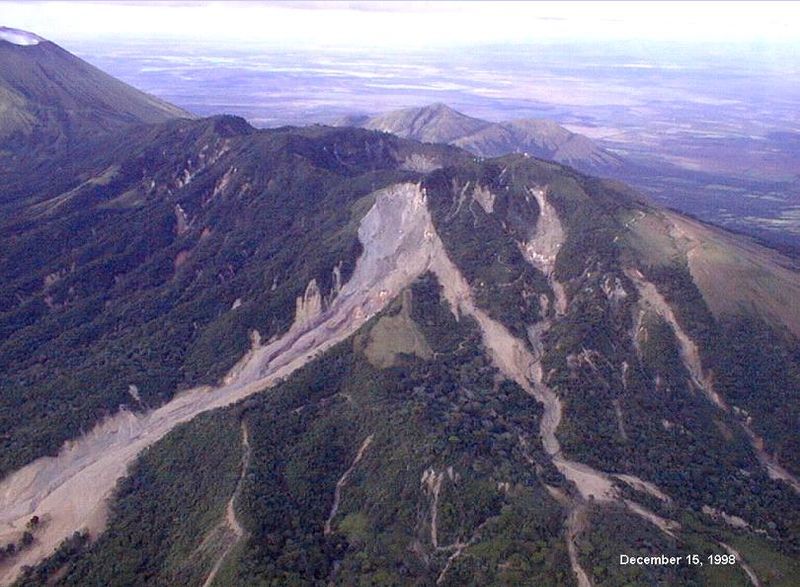5 April 2009
The Casita landslide revisited
Posted by Dave Petley
One of the most deadly hurricanes of modern times was Hurricane Mitch, which tracked across Central America in late October 1998. Many of the tens of thousands of victims were killed by landslides. Perhaps the most notable event was a lahar (a volcanic landslide) that swept down from near the summit of Casita volcano in Nicaragua, killing about 2500 people over the course of its 6 km path (and some more in the hyper-concentrated flow (debris rich flood) events that travelled a further 10 or so kilometres from the toe of the slide. Unfortunately, despite the magnitude of this event the amount of published literature about it has remained quite limited. It is therefore terrific that a paper has just been published by Graziola Devoli and her colleagues (Devoli et al. 2009) that seeks to summarise the published and unpublished reports about this remarkable landslide.
Wikipedia has a very decent image of the upper track of the landslide, which gives a pretty good idea of the scale of this event:
 Whilst MDA have a great overview image of the source, track and runout zone:
Whilst MDA have a great overview image of the source, track and runout zone:
 Complex landslides such as this are poorly understood. In particular, as in the landslides that I highlighted in Sichuan, the mechanisms of initiation and movement are quite intricate. Devoli et al. (2009) have used a range of geological, geotechnical and analytical techniques to get a better idea of what happened.
Complex landslides such as this are poorly understood. In particular, as in the landslides that I highlighted in Sichuan, the mechanisms of initiation and movement are quite intricate. Devoli et al. (2009) have used a range of geological, geotechnical and analytical techniques to get a better idea of what happened.
The landslide was triggered by very heavy rainfall – they suggest that about 750 mm (that’s about a years worth for where I live) of rain fell in a little over 80 hours. Interestingly, they conclude that the landslide can be divided into three key phases:
- Failure started in a fractured and altered volcanic breccia in the northern area of the scarp which released a volume of about 260,000 cubic metres. The flow that developed from this failure swept downslope and entrained colluvium deposits at the toe of the slope in the southern part in less than about 40 seconds.
- The rapid removal of the colluvium on the slope triggered a second failure. This also originated in the scarp shown on the image above. In this phase about 640,000 cubic metres of volcanic breccia slipped over a unit of clay-rich pyroclastic deposits. It is unclear as to whether this flow joined the first one or occurred separately. Either way, blocks in this flow travelled 9 km or more downslope.
- The third and final stage consisted of a as a sudden debris / rock avalanche that originated in the uppermost section of what is how the landslide scar. This failure, with a volume of 690,000 cubic metres, appears to have occurred very soon after the first two events.
In the aftermath there has been considerable concern raised about the likelihood of failure of the entire flank of Casita Volcano (indeed, even I have published on this theme – see van Wyck de Vries et al. 2000). The paper concludes that under conditions of high groundwater instability of these flanks can occur, although as we understand these very large failures so poorly I would be cautious in the interpretation of this particular result. This is a slope that needs an active monitoring programme for sure.
References
Devoli, G., Cepeda, J. and Kerle, N. 2009. The 1998 Casita volcano flank failure revisited — New insights into geological setting and failure mechanisms. Engineering Geology, 105, 65-83.
van Wyk de Vries, B., Kerle, N., Petley, D., 2000. A sector collapse forming at Casita
volcano, Nicaragua. Geology 28, 167–170.


 Dave Petley is the Vice-Chancellor of the University of Hull in the United Kingdom. His blog provides commentary and analysis of landslide events occurring worldwide, including the landslides themselves, latest research, and conferences and meetings.
Dave Petley is the Vice-Chancellor of the University of Hull in the United Kingdom. His blog provides commentary and analysis of landslide events occurring worldwide, including the landslides themselves, latest research, and conferences and meetings.
Perfect timing! I’m finishing up a paper on the Casita collapse for a class on geologic hazards and risk, and I just went through the Devoli paper. It was very helpful, especially in describing the human side of the disaster (since a lot of the old news reports mostly concentrated on Clinton’s visit and not the victims).
About the human side of the Casita disaster have a look to http://www.ineter.gob.ni/geofisica/vol/casita/[email protected]
[…] of a volcano fails, usually catastrophically, generating a landslide (look at the comparatively small landslide at Casita to see just how damaging these landslides can be). These slides can be really big – tens or […]
I visited the area May 1999 and was able to meet some of the survivors. So sad. Life changing.
[…] at the moment this event does not seem to be on a par – Mitch killed 11,000 people. This included a terrible lahar from Casita volcano in Nicaragua, which killed about 2,500 people. At the moment this event seems to be far less severe, but it is a reminder of the terrible […]